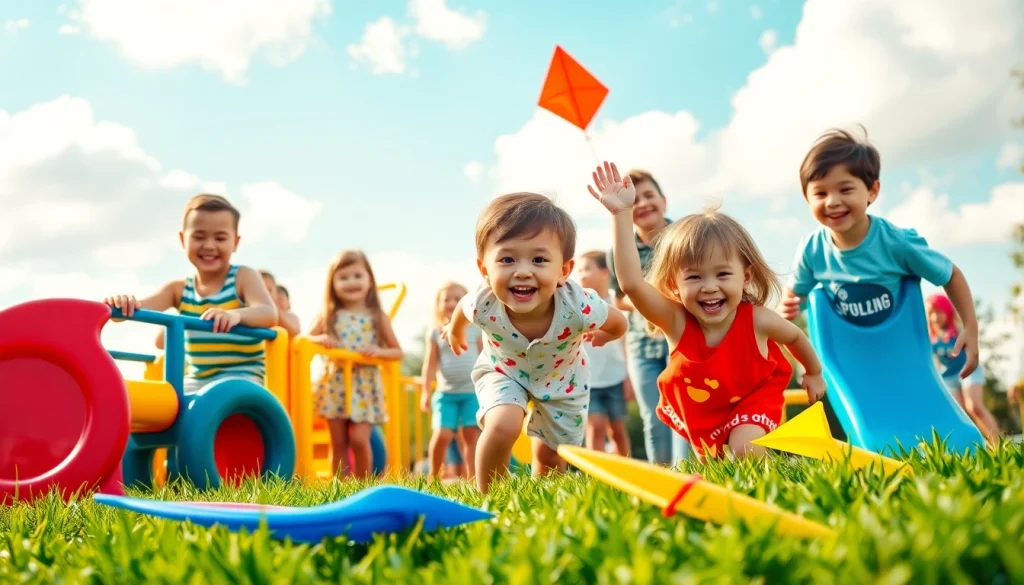
Understanding Kids Entertainment Needs
In today’s fast-paced and digital-centric world, understanding the kids entertainment landscape is more important than ever for parents, educators, and event planners. Engaging kids in meaningful activities not only enhances their creativity but also supports their emotional and social development. By analyzing various aspects of children’s entertainment, we can better cater to their unique needs and preferences.
Why Kids Entertainment Matters
The significance of kids entertainment extends far beyond mere amusement. Engaging recreational activities can foster critical life skills, enhance cognitive abilities, and encourage healthy social interactions. Importantly, structured entertainment can also provide a welcome respite from screen time, promoting physical activity and encouraging creativity.
Research indicates that interactive and participatory entertainment fosters retention of knowledge and skills, setting a foundation for lifelong learning. Moreover, entertainment tailored specifically for kids can instill confidence and a sense of achievement in performing tasks and mastering new activities, vital attributes in their developmental journey.
Different Forms of Kids Entertainment
Kids entertainment is diverse, ranging from traditional forms like storytelling and arts and crafts to modern technological options like video games and virtual reality experiences. Each form caters to different age groups and interests:
- Creative Arts: Engaging in arts and crafts can stimulate creativity and enable self-expression through various materials like paint, clay, and fabric.
- Outdoor Adventure: Activities such as hiking, scavenger hunts, and team sports offer not only physical benefits but also opportunities for teamwork and leadership.
- Educational Programs: Interactive workshops and museums make learning fun and provide hands-on experiences that reinforce academic concepts.
- Technology: Video games or coding classes can enhance technical skills and problem-solving abilities, bridging entertainment with education.
Recognizing Children’s Interests
Each child is unique, and understanding their interests is crucial for effective entertainment planning. Conducting informal surveys, observing behaviors, and engaging in conversations can help identify what captivates their attention. Ask open-ended questions to discover what activities they enjoy, whether it’s crafting, sports, or storytelling. Tailoring activities to match these interests can significantly enhance engagement and enjoyment.
Planning Effective Kids Entertainment
Planning a successful kids entertainment strategy involves careful consideration of multiple elements, including goals, types of activities, and budgeting. A well-organized approach ensures maximum enjoyment and effectiveness.
Setting Goals for Kids Entertainment
Establishing clear objectives for entertainment activities lays a strong foundation for successful engagement. Goals might include enhancing social skills, promoting physical activity, or fostering creativity. By defining what you wish to achieve, you can curate activities that align well with both children’s needs and your overall vision.
Consider using the SMART criteria (Specific, Measurable, Achievable, Relevant, Time-bound) to outline your entertainment goals. For example, a specific goal could focus on a weekly arts and crafts activity to boost creativity, while a measurable aspect could evaluate the improvement of fine motor skills over time.
Choosing the Right Activities
Selecting suitable activities is paramount to achieving your entertainment goals. Factors such as age, interests, and physical abilities should guide your choices. Always ensure the activities are appropriate and engaging:
- Age Appropriateness: Arts and crafts may be suitable for younger children, while teens might prefer engaging in coding or gaming activities.
- Interest Alignment: If kids show interest in nature, consider activities like gardening or nature walks.
- Group Dynamics: Cooperative games or team sports can promote teamwork and social skills.
Budgeting for Kids Entertainment
Budgeting for kids entertainment activities requires careful planning and creativity. It’s essential to allocate resources effectively while maintaining quality experiences. Here are some strategies to consider:
- Identify Funding Sources: Assess what funding is available—whether it be personal funding, sponsorships, or community grants.
- Leverage Community Resources: Local libraries, community centers, and parks often provide free or low-cost activities for children.
- DIY Activities: Crafting and DIY projects can be budget-friendly options that also promote creativity and involvement.
Popular Trends in Kids Entertainment
As times change, so do the trends in kids entertainment. Understanding current trends can help in planning relevant and engaging activities that keep children excited and involved.
Outdoor vs. Indoor Kids Entertainment
With the increasing emphasis on health and wellness, outdoor kids entertainment has gained immense popularity. Activities like hiking, playground visits, and sports not only provide physical benefits but also foster social interactions.
However, indoor entertainment remains significant, particularly during inclement weather. Indoor crafts, cooking sessions, and games can provide enriching experiences regardless of external conditions. Ultimately, a balanced approach incorporating both outdoor and indoor activities can cater to different preferences and situations.
Technology in Kids Entertainment
The impact of technology on kids entertainment cannot be overstated. From educational apps to interactive virtual reality experiences, technology has redefined how kids interact with entertainment. Leveraging technology can enhance learning through gamification and interactive content.
Nevertheless, it’s crucial to maintain a balance. Monitoring screen time and encouraging offline activities can prevent overreliance on technology, ensuring a well-rounded entertainment experience.
The Role of Imagination in Kids Entertainment
Your imagination plays a pivotal role in kids entertainment. Activities that stimulate imagination, such as role-playing games, storytelling, and creative arts, pave the way for innovative thinking and problem-solving skills. Encouraging imaginative play allows kids to explore different scenarios, fostering empathy and emotional intelligence.
Consider organizing themed events that ignite the imagination—be it a dress-up party or a storytelling session where kids create their own narratives. These activities empower children to express themselves while developing social bonds with peers.
Executing Fun Kids Entertainment Activities
Transforming plans into successful kids entertainment activities involves meticulous execution. Factors such as safety, organization, and parental involvement play crucial roles in ensuring a successful experience.
Safety Considerations for Kids Entertainment
Safety should be a paramount consideration in all entertainment activities. Ensuring a secure environment both indoors and outdoors can prevent mishaps and ensure parents’ peace of mind. Here are some essential safety measures:
- Supervision: Always ensure that children are adequately supervised during activities.
- Risk Assessment: Identify potential hazards in the environment and take appropriate measures to mitigate them.
- Emergency Preparedness: Have a plan in place for emergencies, including first-aid training for supervisors and readily available emergency kits.
Steps to Organize a Fun Event
Organizing a memorable kids entertainment event requires careful planning and attention to detail. Here’s a simplified step-by-step guide:
- Define the Purpose: Decide whether it’s a birthday party, educational workshop, or community gathering.
- Choose a Theme: Selecting a fun theme can make the event more exciting and cohesive.
- Select Activities: Plan a variety of age-appropriate activities to keep kids engaged.
- Logistics: Consider venue, timing, invitations, and equipment needed for activities.
- Invite Feedback: Involve parents in planning by seeking their input and inviting them to participate.
Engaging Parents in Kids Entertainment
Involving parents in kids entertainment is an excellent way to enhance the experience for children. Parents can assist with planning, chaperoning, or even leading activities, which fosters a positive community spirit. Here are some strategies to engage parents:
- Communication: Keep parents informed about planned activities and how they can assist.
- Volunteer Opportunities: Encourage parents to volunteer for various roles, from leading activities to organizing supplies.
- Feedback Loop: Create channels for parents to provide feedback, ensuring that their voices are valued in the planning process.
Evaluating Kids Entertainment Effectiveness
After executing kids entertainment activities, taking the time to evaluate their effectiveness is vital. This process allows for continued improvement and ensures that children’s needs are being met.
Gathering Feedback from Kids
Listening to children’s feedback is instrumental in assessing the enjoyment and engagement level of activities. Creating a friendly environment for kids to express their thoughts makes them feel valued and encourages future participation. Use methods such as:
- Surveys: Simple questionnaires can gauge what kids liked or disliked about the activities.
- Group Discussions: Hosting a casual discussion can evoke spontaneous feedback that structured surveys may not capture.
- Observational Insights: Monitor participation levels and enthusiasm during activities to gather qualitative insights.
Measuring Success of Kids Entertainment Activities
Measuring the success of entertainment activities involves identifying quantifiable metrics to analyze outcomes. Key metrics could include:
- Participation Rates: Evaluate how many children attended and participated actively in the activities.
- Skill Development: Assess improvements in specific skills (e.g., social interactions, physical abilities) post-activity.
- Overall Satisfaction: Use feedback from kids and parents to score their overall experience and satisfaction with the event.
Making Improvements for Future Kids Entertainment
Continuous improvement is essential to delivering outstanding kids entertainment experiences. Use the evaluation findings to make informed adjustments for future activities by:
- Identifying Trends: Look for patterns in feedback to determine what works and what needs improvement.
- Incorporating New Ideas: Stay informed about emerging trends and include them in future plans to keep experiences fresh.
- Engaging Stakeholders: Continue to involve parents and children in the planning stages to ensure that offerings resonate with the audience.





